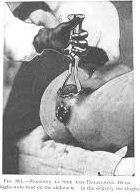 Maternal mortality in the past and its relevance to developing countries today
Maternal mortality in the past and its relevance to developing countries today
Spoiler alert:
Midwives: Yes! Over the last two hundred-plus years professional midwives as a normal part of the maternity care system were the safest birth attendants when compared to physician-attended births. Midwives had a two-to-ten fold lower maternal mortality rate than normal births attended by physicians.
Physicians: Not so much! The major danger to childbearing women in developed countries (particularity in the United States and the UK) was unnecessary interference in physician-attended births.
In the US, the medical profession promoted the idea that pregnancy was a nine-month disease that required a surgical cure. Doctors J. Whitridge Williams and Dr. Joseph DeLee were the primary architects of a new hospital-based system that defined obstetrics as a surgical specialty and childbirth as a surgical condition.
Labor was treated as a pathologically painful condition requiring large and frequently repeated doses of narcotics and the amnesic-hallucinogenic drug scopolamine. Normal birth a surgical procedure required the mother to be rendered unconscious with chloroform or ether, followed by a routine episiotomy, forceps delivery and manual removal of the placenta while the mother was under the effects of a general anesthesia.
In this pre-antibiotic era, infection from these invasive procedures the single most frequent cause of maternal death in the US and the UK.
ABSTRACT
INTRODUCTION
HISTORICAL TREND IN MATERNAL MORTALITY RATES
This question is important because, unlike disease-specific mortality rates, no other mortality rates showed such a profound decline in the second half of the 20th century. The risk of women dying in childbirth in the 1920s and 1930s was still as high as it had been just after Queen Victoria came to the throne in the 1850s. Today, however, the risk of women in England and Wales dying is between 40 and 50 times lower than it was 60 y ago.
Annual maternal mortality rates in England and Wales, 1880–1980. Data from references1–3.
Annual maternal mortality rates in England and Wales, 1880–1980. Data from references1–3.
Annual maternal mortality rates in the United States, England and Wales (E and W), and Sweden, 1890–1950. Data from references1–3,8,9.
Puerperal fever and antisepsis
Maternal mortality, home deliveries, and midwives

 Similar low levels of maternal mortality were achieved during the 1920s and 1930s in the United States by a remarkable service in the history of maternal care that was founded by Mary Breckinridge. Midwives in the Kentucky Frontier Nursing Service traveled on horseback to assist with deliveries, which were all at home in a poor rural farming community with low living standards.
Similar low levels of maternal mortality were achieved during the 1920s and 1930s in the United States by a remarkable service in the history of maternal care that was founded by Mary Breckinridge. Midwives in the Kentucky Frontier Nursing Service traveled on horseback to assist with deliveries, which were all at home in a poor rural farming community with low living standards. Maternal mortality rates during deliveries undertaken by the Kentucky Frontier Nursing Service, 1925–1937, compared with maternal mortality rates in other local and general populations of the United States in the same period1
| Population | Maternal mortality rate |
| (deaths/100000 births) | |
| Women delivered by the | |
| Kentucky Frontier Nursing Service | 60–70 |
| White women of Kentucky | 440–530 |
| White women delivered by physicians in hospitals in the city of Lexington, KY | 800–900 |
| United States | |
| Total | 560–700 |
| White | 510–630 |
| Nonwhite | 900–1200 |
| Population | Maternal mortality rate |
| (deaths/100000 births) | |
| Women delivered by the | |
| Kentucky Frontier Nursing Service | 60–70 |
| White women of Kentucky | 440–530 |
| White women delivered by physicians in hospitals in the city of Lexington, KY | 800–900 |
| United States | |
| Total | 560–700 |
| White | 510–630 |
| Nonwhite | 900–1200 |
High maternal mortality due to unnecessary interference
 In contrast with the above findings, maternal mortality rates were very high in countries, states, regions, or areas where most deliveries were performed by physicians, especially in the hospital.
In contrast with the above findings, maternal mortality rates were very high in countries, states, regions, or areas where most deliveries were performed by physicians, especially in the hospital. His advice was heeded by many obstetricians and horrendous examples of iatrogenic mortality resulted. Another example, from Britain, was the widespread use of chloroform and forceps by general practitioners in uncomplicated deliveries between ≈1870 and the 1940s.
His advice was heeded by many obstetricians and horrendous examples of iatrogenic mortality resulted. Another example, from Britain, was the widespread use of chloroform and forceps by general practitioners in uncomplicated deliveries between ≈1870 and the 1940s.Maternal mortality and social class
| Social class2 | ||||
| Causes | I and II | III | IV | V |
| (deaths/100000 births) | ||||
| All | 444 | 411 | 416 | 389 |
| Abortion | 50 | 56 | 56 | 57 |
| Puerperal fever | 145 | 133 | 121 | 116 |
| Hemorrhage | 50 | 44 | 48 | 60 |
| Toxemia | 81 | 81 | 84 | 68 |
| Social class2 | ||||
| Causes | I and II | III | IV | V |
| (deaths/100000 births) | ||||
| All | 444 | 411 | 416 | 389 |
| Abortion | 50 | 56 | 56 | 57 |
| Puerperal fever | 145 | 133 | 121 | 116 |
| Hemorrhage | 50 | 44 | 48 | 60 |
| Toxemia | 81 | 81 | 84 | 68 |
Causes of decline in maternal mortality after the mid-1930s
Annual maternal mortality rates attributable to puerperal fever and to all other causes (logarithmic scale), in England and Wales, 1920–1945. Data from reference 6.
Annual maternal mortality rates in the United States, Australia, England and Wales (E and W), Sweden, and the Netherlands, 1925–1950. Data from reference 6.
Annual maternal mortality rates in the United States, Australia, England and Wales (E and W), Sweden, and the Netherlands, 1925–1950. Data from reference 6.
| Cause of death | |
| % | |
| 1872–1876 (n = 23051)1 | |
| Puerperal fever | 55.5 |
| Hemorrhage2 | 21.0 |
| Puerperal convulsions | 11.6 |
| Miscarriage and abortion | 4.0 |
| Puerperal mania | 2.5 |
| Phlegmasia dolens3 | 2.0 |
| Retained placenta | 1.5 |
| Extrauterine foetation | 0.2 |
| Other | 0.8 |
| 1976–1981 (n = 393)4 | |
| Hypertensive diseases | 20.4 |
| Pulmonary embolism | 13.0 |
| Ectopic pregnancy | 11.4 |
| Amniotic fluid embolism | 10.2 |
| Abortion | 8.0 |
| Hemorrhage | 8.0 |
| Puerperal fever | 4.6 |
| Ruptured uterus | 2.2 |
| Other | 9.7 |
| Cause of death | |
| % | |
| 1872–1876 (n = 23,051)1 | |
| Puerperal fever | 55.5 |
| Hemorrhage2 | 21.0 |
| Puerperal convulsions | 11.6 |
| Miscarriage and abortion | 4.0 |
| Puerperal mania | 2.5 |
| Phlegmasia dolens3 | 2.0 |
| Retained placenta | 1.5 |
| Extrauterine foetation | 0.2 |
| Other | 0.8 |
| 1976–1981 (n = 393)4 | |
| Hypertensive diseases | 20.4 |
| Pulmonary embolism | 13.0 |
| Ectopic pregnancy | 11.4 |
| Amniotic fluid embolism | 10.2 |
| Abortion | 8.0 |
| Hemorrhage | 8.0 |
| Puerperal fever | 4.6 |
| Ruptured uterus | 2.2 |
| Other | 9.7 |
The profound decline in maternal mortality rates since World War II has been completely dependent on accurate data for both the number and causes of maternal deaths.
In the late 1940s, which were the early years of the National Heath Service, the British Ministry of Health introduced the system of confidential inquiries into the recording of maternal deaths, and every maternal death was subject to the most intense, but confidential, inquiry. It was perhaps the first official example of what has become known as a clinical audit.
It is impossible to know what would have happened without this system of continuous audit, but the reports certainly give the impression that they identified the avoidable maternal deaths and led to ways of preventing such deaths.
NUTRITION AND MATERNAL MORTALITY
The significance of the features described in the above section suggest that there were 3 main determinants, but not necessarily causes, of maternal mortality in the past: the social and economic status of birthing women, the standard of obstetric care, and the virulence of streptococcus.
Streptococcal virulence is an immensely complex subject that is not directly related to the topic of anemia and maternal mortality and will not be discussed here.
It is not known whether maternal mortality rates were high in the past primarily because the health of women was impaired, especially in terms of nutrition and anemia, or because of the standard of maternal care.
It does not appear that there were any surveys on anemia in populations of expectant mothers before the 1930s and, even if there were, the accuracy of the measurements would be questionable because of the assessment techniques available at that time. There are, however, copious data on maternal mortality rates in poverty-stricken populations, in whom it is reasonable to assume that malnutrition was prevalent, and some physicians believed malnutrition was the underlying cause of high maternal mortality.
For example, a medical officer of health in the 1930s said, with a touch of exasperation, that what was needed in South Wales (an area well known for having high maternal mortality) was a herd of cows and not a herd of obstetricians (19). Although a memorable remark, it is likely that he was wrong.
There is overwhelming evidence that social and economic conditions were very weak determinants of the levels of maternal mortality, whereas the standard of obstetric care was a very strong determinant.
However, this may not be true in situations in which nutritional status is so low that it approaches starvation.
Under the conditions of poverty and associated malnutrition that were seen in parts of developed countries in the 19th and first half of the 20th century, it was care at parturition and not malnutrition and other concomitants of poverty that determined the level of maternal mortality.
Although it can be argued that social status and standards of maternal care were not wholly independent variables, because the rich could buy what they thought was the best maternal care and the poor could not, the reduction in maternal mortality in the past was generally independent of the economic status of the mothers. This is exemplified in the following 2 cases.
The industrial town of Rochdale in northwestern England had, in the early 1930s, the unenviable distinction of having the highest rate of maternal mortality in the country. Most of the population was poor, deprived, and malnourished. Rochdale also had an appalling standard of maternal care.
In 1930, an exceptionally vigorous medical officer of health was appointed who totally reformed maternal care in Rochdale. Although there was no change in social conditions, maternal mortality rates decreased within a few years from 900/100000 births (compared with 400–500 maternal deaths in England as a whole) to 170 maternal deaths and this low rate was sustained (15).
The second example comes from the United States, where a religious group in the state of Indiana, called the Faith Assembly, was investigated in the early 1980s.
This sect consisted of well-nourished, middle-class, white citizens who had ordinary middle-class jobs. Their religion, however, led them to reject all forms of orthodox medicine, including the services of obstetricians and midwives. Maternal care consisted of prayer and delivery by family or friends.
Maternal mortality in this group was 872/100000 births compared with 9/100000 for Indiana as a whole, a rate that was 92 times higher (95% CI: 19, 280) than that for the remainder of Indiana (20).
High and low rates of maternal mortality have never corresponded to changes in economic conditions (6). Most notably, US maternal mortality rates declined steadily from the beginning of—and throughout—the great depression of the 1930s(Figure 2).
CONCLUSIONS
In developed countries until the mid-1930s, maternal mortality rates were high. The major determinants of the high levels of maternal mortality were the standard of care at delivery and the virulence of Streptococcus pyogenes, which caused almost all deaths from puerperal fever.
It was certainly true that before 1937—and probably thereafter—malnutrition associated with poverty was a surprisingly minor determinant of levels of maternal mortality.
High maternal mortality was substantially reduced only by providing high-quality maternal care by the standards of the time, not by improving the diet.
The sudden and dramatic decline in maternal mortality rates, which occurred after 1937, took place in all developed countries and eliminated the previously wide country-level differences in national mortality rates.
The main factors that led to this decline seem to have been successive improvements in maternal care rather than higher standards of living. As a result of this decline in maternal mortality in developed countries, there is now no mortality for which there is a greater disparity between the developed and the developing world than the disparity in maternal mortality rates.
Interventions to reduce maternal mortality rates are likely to be much more effective if the underlying causes are known. This is particularly true when the underlying causes vary in extent, importance, or both, among developing countries. For this reason and despite the practical difficulties in doing so, it is important to assess attributable risk of maternal mortality in developing countries. In other words, it is important to identify the causes of maternal mortality whenever possible and to try to estimate the degree of certainty in the data.
DISCUSSION
Dr Ladipo: I was very impressed by your graph on maternal mortality from Britain and one Nordic country. One thing that struck me was that most of the natural decline in maternal mortality was after 1940, which coincided with the introduction of the National Health Service, when every individual in the United Kingdom had access to good care.
In addition, in a welfare state, people may have been disadvantaged or unemployed, but the fact that they had reasonable income from the government meant that at least their level of nutrition would be within acceptable limits. Other factors that were more important for the sharp decline in maternal mortality were the use of antibiotics, availability of blood transfusion, and reduction in the high-risk pregnancies in the United Kingdom—notably teenage pregnancy and grand multiparity.
Contraceptive use and acceptance by the wider population increased over time, particularly after the 1930s, and the role of contraception in that graphic change should not be overlooked in the discussion. The availability of contraception and improved health care services that were due to the National Health Service improved blood transfusion services and access to operative delivery and may have made a contribution to that reduction.
Dr Loudon: The beginning of the sudden improvement in maternal mortality was in 1937 (Figure 1). In the first few years, it was almost entirely due to the introduction of sulfonamides and later penicillin, and this applied to other countries as well. If the decline is plotted on a logarithmic scale, you get a straight line.
Richard Doll (personal communication, 1993) remarked that this showed that the decline was not due to one factor but to many.
The factors that may have been responsible were, first, sulfonamide and penicillin for infection; second, ergometrine use to reduce postpartum hemorrhage; third, universal blood transfusion; and fourth, much better cooperation and better medical education and so on.
What is interesting was that although the decline was partly due to the National Health Service, the fall occurred at the same rate in almost every country in the world. Figure 4 shows a huge disparity in maternal mortality rates among the United States, Australia, England and Wales, and the Netherlands before 1937, but after that it converges. By 1946, maternal mortality in these countries was separated by a whisker. There were ≈60 deaths for every 100,000 births and every country congratulated itself on its obstetric services.
The United States said “this was a triumph of capitalism and modern medicine.”
Australia said, “We Australians have always been the best.”
Britain said, “It is the National Health Service.”
Sweden and the Netherlands said, “It is our marvelous service.”
Maybe each was right, but you can produce your own explanation. The disparity disappears almost completely by 1960 and has continued to today, where only a hairbreadth’s difference in maternal mortality rates exists among these countries.
Dr Ladipo: You talked about the pattern from 1850 onwards. What happened before 1850?
Dr Loudon: The important work was by Wrigley and Schofield, who wrote a population history of England [Wrigley EA, Schofield RS. The population history of England. A reconstruction. Cambridge: Cambridge University Press, 1981].
They found maternal mortality rates were certainly higher at ≈400–500 per 100,000 births throughout the 19th century. It was a bit higher at the beginning of the 19th century and was up to perhaps 1000 per 100,000 births in the early part of the 18th century.
I have a graph in my book [Loudon I. Death in childbirth. Oxford: Clarendon Press, 1992] that shows maternal mortality stretching back in history and, as you go back, it goes up very slightly and then we lose track because there really are no data as yet.
Nevertheless, a dramatic fall in maternal mortality did not occur until 1937. A more dramatic fall was observed for Sweden, but that is another issue.
There is one recent and absolutely fascinating fact that does not affect maternal mortality at all, but it affects the topic we are talking about today. If you trace back infant mortality divided into neonatal and post-neonatal mortality right through the 19th century, post-neonatal mortality rates were much higher than neonatal rates, and that continued into the 20th century. Then, both mortality rates declined, but the neonatal rate went down more slowly than the post-neonatal rate, as expected.
The crossover point was ≈1950, after which neonatal mortality was higher than post-neonatal.
It has recently been discovered that for reasons that none of us can fathom, between 1700 and 1750 neonatal mortality was higher than post-neonatal mortality. After this time, both mortality rates suddenly came down, crossed over, and adopted the position described above for the next 150 y. This is purely a point of academic fascination, discovered by Professor Wrigley. I do not know the explanation, and we have discussed it back and forth.
To come back to your original question, there was a slight fall in maternal mortality rates through the 18th century as far as we know. Indirect work, including Wrigley and Schofield’s brilliant work on parish records, has confirmed that there was not much of a fall in maternal mortality rates then in the United Kingdom.
We do not know what happened in other countries except in Sweden where there was a profound fall.
Dr Maine: Are there situations in maternal mortality where each attributable and relative risk might have advantages?
Dr Loudon: As far as there is any analogy—and a very slight analogy may exist between historical work and modern work in the developing world—my feeling is that trying to get the best figures you can on attributable risk is essential, but you must recognize that it is an extremely difficult thing to do. You have to try to estimate the range of error in the data that you get, but without at least trying to do so I think you are hamstrung in trying to intervene.
 Please download the PDF to access the reference, as I could not import the formating. Also the the references for the above graph are almost undecipherable, so they too should be taken from the PDF.
Please download the PDF to access the reference, as I could not import the formating. Also the the references for the above graph are almost undecipherable, so they too should be taken from the PDF. 